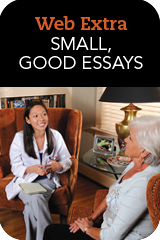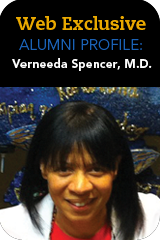Chasing Challenges with Dean Watts
By Charles Buchanan
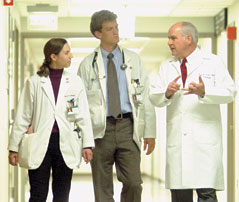 |
Watts believes in the power of collaboration—across UAB's campus and throughout the state—to improve the health of Alabamians. |
Ray Watts made the choice that would change his life when the phone rang one sunny Saturday in April. The college senior had earned a spot in one of the nation’s most prestigious graduate engineering programs. The Massachusetts Institute of Technology was literally and figuratively on the line. Would he accept?
No, Watts told them. He was going to medical school instead. He wanted to chase the bigger challenge. Thirty-four years later, another decision has presented Watts with his greatest challenge yet: leading the School of Medicine forward as dean and senior vice president for medicine.
“Many friends have asked what in the world I’m thinking to become dean at this time in American medicine,” he says. “My answer is that we can either be pessimistic or excited about the future. I am in the latter camp.”
At each turning point in his career, Watts has gravitated toward the toughest choices. That winding path has led to accomplishments in academic medicine and world-renowned breakthroughs in Parkinson’s disease research and care. Before becoming dean, the 56-year-old Birmingham native led the UAB Department of Neurology as the John N. Whitaker Endowed Chair, was chief of the UAB Hospital Neurology Service, and served as president of the University of Alabama Health Services Foundation (HSF). “The joy that I’ve experienced comes from attacking important problems and working with others to add knowledge and bring that to bear on the diseases affecting our patients, families, and communities,” Watts says.
Now his challenges include the uncertainties of health care reform and tight research budgets at the National Institutes of Health. The good news is that UAB investigators are highly competitive in securing funding, Watts says. As for health care reform, “we have to make sure it changes medicine in a positive way. We have studied it carefully and are building a thoughtful, proactive response.” UAB has many opportunities to lead under the legislation, he adds. “We’re going to try new things and be innovative, but not let the outstanding quality of our care deteriorate.”
Engineering New Strategies
Watts knows quite a bit about the structure and organization of complex systems. Upon graduating from Birmingham’s West End High School, the science and math aficionado planned to become an electrical engineer. He first encountered biomedical research as a UAB undergraduate, spending a summer in a lab working with engineers who studied speech articulation. The science—and the body’s many mysteries—excited him. “Biological systems are nonlinear, unlike mechanical and electrical systems, and they were hard to model,” he says. “The body is a combination of these complex systems, but it’s all built on fundamental principles.”
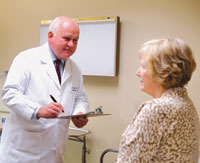 |
Watts is spearheading new strategic plans to redefine the school's approaches to teaching, research, and primary care. |
The complex system known as the School of Medicine also adheres to fundamental principles—its mission of teaching, research, and patient care. Watts aims to reinvigorate all three with a comprehensive strategic planning process.
In November, Watts initiated a review and update of the school’s research and education plans, and he began developing a primary care plan. He started the process by examining each clinical and Joint Health Sciences department to gain a greater understanding of their strengths, challenges, and goals. By spring 2011, all three plans will be ready for rapid implementation, with tangible milestones to assess progress.
The school’s plans will complement the UAB Health System’s clinical strategic plan positioning UAB as the preferred academic medical center of the 21st century, known as AMC21. As HSF president, Watts became intimately familiar with AMC21 and its emphasis on excellence and innovation. “From the beginning, our plan has been to integrate research and educational strategic planning with clinical care so that they synergize and strengthen our overall mission.” See the basic outlines of the plans.
Growth Factors
At Washington University School of Medicine in St. Louis, Watts quickly found his niche in neuroscience, gravitating to adult neurology. With his background in engineering and signal processing, he relished the challenge of discovering how the brain works. Watts honed his specialty with a residency at Massachusetts General Hospital and a fellowship at the National Institute of Mental Health. There he began to focus on the brain’s connections to movement disorders such as Parkinson’s disease.
Then he faced another choice: Take the “perfect job” at Columbia University, home to the nation’s biggest and best movement disorders program, or go to Emory University, where no such program existed.
Watts headed to Atlanta. “Emory was a young organization, much like UAB, with a lot of energy,” Watts says. Over the next 17 years, he helped his department grow from 12 faculty to around 70. “We moved from nowhere into the top five in NIH funding, and we built a world-class movement disorders center.”
Watts hasn’t lost one watt of that energy. At the SOM, he plans to add at least 100 net new faculty in clinical departments, Joint Health Sciences departments, and collaborating academic units over the next five to six years. Such gains would likely allow UAB to advance further in NIH rankings, but Watts emphasizes that high-impact discoveries that transform biomedical science and medical treatments for serious diseases are far more important than rankings.
He also promises to “recognize and reward” current faculty by positioning them for national leadership roles—and by involving both senior and junior faculty in the strategic planning process. “We need to invigorate our can-do attitude. The best and brightest people want to be at a place aiming for great achievements,” he says.
Watts also wants to set priorities. “No place can be the best in everything. We’re going to have to focus on strategic areas where we can be among the best in the country and the world—areas where we have the greatest opportunities and that reflect our greatest strengths. By investing in these, we can create programs that attract the best faculty and students, research grants, philanthropy, and patients from all over the country.”
Collaboration is another crucial goal. Watts plans to build relationships with physicians across Alabama—the people caring for the patients who will ultimately benefit from the school’s growth—through UAB’s continuing medical education programs, the Medical Alumni Association (MAA), the Medical Association of the State of Alabama (MASA), and health-professional organizations. He also wants to involve other schools on UAB’s campus in SOM initiatives. “We can learn from each other,” he says.
Watts is especially excited about meeting the school’s alumni, hearing their ideas, and encouraging them to support the growth of the school. “It’s a natural partnership,” Watts says. “Our alumni have a lot to share, and I want them to be involved with our current students, our house staff, and our faculty. Their degrees are going to become more valuable as they go forward and keep learning, keep growing, and keep helping others. I want us to partner with them to help provide the best care to our citizens and to define the future of medicine.”
Pushing the Envelope
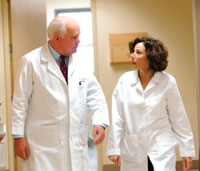 |
Watts is optimistic about UAB's prospects in a new era of American health care. "We are going to change the future of medicine and biomedical science," he says. |
Inside a lab at Emory, Watts made a discovery about himself. Though he loved basic science research, he was growing impatient. He wanted to quicken the development of treatments for patients suffering from debilitating neurological diseases.
He refocused his career toward translating research breakthroughs into clinical innovations—which brought him back to UAB in 2003. “One thing that attracted me was the chance to create a new kind of center, the Center for Neurodegeneration and Experimental Therapeutics,” he says. “We’re studying brain diseases with progressive cell death either in memory pathways or movement pathways, but with a focus on taking animal or molecular models, learning what goes wrong, and developing targeted therapies. Our goal is to develop disease-modifying neuroprotective therapies that will cure Huntingdon’s disease, Lou Gehrig’s disease, Parkinson’s, Alzheimer’s, and others.”
As UAB neurology chair, Watts also spearheaded the creation of the Comprehensive Neuroscience Center, “a collaborative environment where we can help each other be more successful.” Investigators are able to work on two or three lines of research rather than only one, multiplying their productivity. Basic scientists interact with clinical scientists, “which is absolutely necessary if we’re going to solve big issues like memory disorders. It takes teams; no individual can do all those things.” Watts notes that more than 200 UAB researchers are now part of the center. “It has transformed our ability to treat these diseases. We don’t have a cure yet, but that’s the next phase.”
In the neurology department and now in the dean’s office, Watts views himself as a venture capitalist. “We must invest in ourselves if we expect others to invest,” he says. “To get where we want to go, we’re going to need to invest hundreds of millions of dollars in institutional as well as philanthropic funds.” His fund-raising goal is $150 million—with $50 million reserved for endowments—and he is confident that it will pay dividends.
“People want to invest in the future, in solutions, in new treatments that are going to make an impact. With institutional support and a forward-looking strategic plan, we can reach out to community members and leaders to partner with us and accelerate our progress. Many of these donations help us take chances and push the research envelope, and if we’re successful, then it leads to more success. That’s what the future’s about.”
Watts says that Alabama’s business and community leaders are ready to invest in UAB. He was pleased to see UAB listed as a top priority in the Birmingham Business Alliance’s new Blueprint Birmingham strategic plan. “The state and community want us to develop our ideas,” he says.
Defining the Future
The new dean isn’t afraid to get his hands dirty. At home he’s an avid gardener who “likes to grow beautiful things.” He also enjoys deep-sea fishing and spending time with his family, which includes his wife, Nancy, a UAB neurology nurse, and five grown children—two of whom are following in his footsteps as physicians.
Now Watts hopes to grow something beautiful at the School of Medicine, and it is a challenge he eagerly accepts. “We have an opportunity to be one of the leading academic medical centers in the country over the coming decade,” he says. “We are going to change the future of medicine and biomedical science.”
